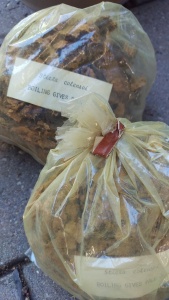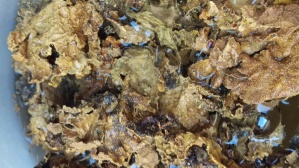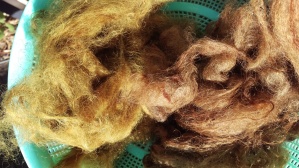Quite some time ago, I became the beneficiary of natural dyes that had been abandoned at, or gifted to, my Guild. Among them were some very old looking bags of dried lichen. I was appalled by this discovery, to be honest. Lichens are slow growing, increasingly threatened, complex organisms. I hear they are plentiful in some parts of the world but I am not living in one of those parts. People far more articulate and knowledgeable than I am on this subject, such as India Flint, have explained why harvesting these plants for dye is not a good idea. However, clearly there was a point in the past when these lichens were harvested and it is too late to make that unhappen. So I have done some research into the lichens that have labels on them. Some of them are so old they have imperial labels on them rather than metric labels. Wikipedia says Australia began metrication of weights and measures in 1971. So you know what I’m saying.
I decided to start with some of the lichens whose labels suggested they should be treated using the boiling water method. The simplest, and the one achievable in winter. First, a soak in rain water. Coral lichen above and Sticta Colensi below. I gave them a 24 hour soak in rain water, and then started the heating. Then there was straining out. Then a contest between dye baths on the go. In the end I decided that since Karen Casselman’s book on lichen dyes pretty clearly recommends long processing, perhaps this was a dye that could spend some time wrapped in a blanket to stay warm between heatings.
The whole time I was working on these two dyes I was thinking about why anyone would harvest lichens to get the colours suggested on the labels which say things like ‘boiling gives gold’ and ‘boiling gives pale olive green’ or even ‘boiling gives warm beige’. And the outcome: Sticta Colensi is the yellow on the left. Coral lichen pale brown on the right. So now we know. Leave them where you find them, my friends. There are faster growing ways of achieving these colours.





I have tried the sort that gives purple with an ammonia solution – following Karen Casselman’s book as you have. they are reasonably plentiful on rocks around the granite hill area where I used to have my house in Spain. obviously this was a one off – just half a jam-jar – it worked, made a lovely pinky purple colour on a cotton jersey bundle already leaf printed, so very subtle. I think in Spain they were exploited for purple dye in the past. but for me only for experimental purposes, taken off some rocks at the bottom of my finca
LikeLike
I have a bag or three of this type of lichen (dried) too. I am building up my nerve to use them but that will need to wait for warmer weather and the kind of careful attention I often don’t really have!
LikeLike
well, much more rewarding, and really very simple, I got some glass cleaner that has ammonia in it, and did all the shaking etc that she tells you to do – it goes the most wonderful colour.
LikeLike
I am sure it isn’t as difficult as it seems!
LikeLike
I applaud your message. The scarce and fragile lichen colonies here do not need our selfish exploitation. I have, however, at workshops in the Porongurups in Western Australia, seen beautiful purples made by fermenting lichens (species unknown so DON’T try this at home ) with strong ammonia solutions. Having said that, I can’t even remember if the purples were light and wash fast.
LikeLiked by 1 person
Thanks, Margaret. I have read about the purples to be had from long fermentation in ammonia and I believe that I have some of these lichens in my possession in the same kind of packages you saw in the post. But I am in complete agreement with you that scarce and fragile lichens do not need further exploitation when every day the conditions of their existence are under threat from development and climate change, just to name a couple of major contributors.
LikeLike
I am amazed at the blogs I read that still use lichens, maybe they are common in some parts of the world but even so it is similar to using coral, another endangered group.
There are enough plants in the world that you can achieve very similar colours from so why use lichens.
LikeLiked by 1 person
I completely agree with you Debbie. Seeing the promises made on the labels of some of these precious lichens, I wonder why not use carrot tops? Nettles? Fennel? We have widespread weeds in this country, as well as trees all over the place that would give these colours from what they drop in a windy night. It gives me comfort to think that never once in all my time in the Guild has anyone suggested to me that this is something I or anyone else should do. These are leftovers from a time when understanding was different. These aged packages are the only lichens I expect to use in my lifetime.
LikeLike
I have never thought of using lichens for dyeing but there do seem to be a lot growing here. I cannot comment on whether they are endangered here but even if they were not, it is never right to use large quantities of wild resources. Too many people, too many wants usually ends in tragedy for some part of the living world.
LikeLiked by 1 person
I completely agree with you Norma. Thoughtfulness is called for. There are many of us humans and we are an extremely destructive species. I keep reflecting on all that has been lost in this continent since it was invaded just over 200 years ago, and yet the destruction has not ended. The suburbs keep spreading. Proposals for mines continue. Forests keep being logged. I do not want to participate in any more of this destruction than I can help, and this is one way that I can simply refrain.
LikeLiked by 1 person
It’s very difficult though. I’ve been trying to change my habits for years so as to participate less in destruction but I don’t think it’s enough.
There have been some big changes in the right direction but there are always people fighting against them.
LikeLiked by 1 person
I am glad both of us are on the project, Norma. With so many others.
LikeLiked by 1 person
What a GREAT post, Mary, it’s an important message. Over here in the wet, wet, wet Pacific Northwest of amerikey we grow lichens by the bushel load. But, although they are plentiful I have refrained from ever experimenting with them. Reason: I usually blab about my dye experiments on my blog & over time the internet has grown to be a such a dodgy place in some regards … I have not wanted to appear that I am promoting the practice in any way, shape or form.
You have “handled” the topic in an honest, yet informative way. Much appreciation from me.
p.s. Shall I admit to being somewhat pleased that your results were quite ordinary? no offense intended, but temptation would abound if there were flaming reds & bright delicious greens, yes??
LikeLiked by 1 person
Thanks, Christi! I appreciate that particular bouquet. There are no bushel loads of lichens anywhere I have been in mainland Australia. The only ones I have considered trying are those on fallen branches on suburban roads where their certain destination is a tip. I live in the driest state, where almost everything takes a long while to grow, it seems! I thought about the not-so-impressive colours too. I have other packages as yet unopened and haven’t had to decide yet whether to post about them. I am not sure I’d blab about glorious colours even though it might well be of interest. I love the way the internet has opened up all manner of information but I think it’s always been clear that information and knowledge are not the same and information and wisdom are very different. In the matter of natural dyeing my knowledge is constantly expanding, and each time it does, the shape of my ignorance becomes a little bit clearer. I share your reservations without having decided how to proceed. It may be that quietly is the answer.
LikeLike
I agree re the judicious use of lichens. I have a friend who is really into dyeing with lichens/mushrooms and as a Forest ranger she knows what can and cannot be picked. Often she can get amazing colours from a 30-50 gm pile of whatever, long slow dye process, sometimes over months. Her favourite site is: http://mycopigments.com/
I use a Wolf Moss that is found all over here and I get it from the ground where it has fallen off trees.
https://en.wikipedia.org/wiki/Letharia_vulpina It dyes a florescent yellow! doesn’t need a mordant and the yarn always smells of pine. I love it.
LikeLike
The mycopigments site is quite amazing. I’ve been there several times to marvel. But yes, judicious use, or (in my context at the very least) no use at all… seems like the best strategy. I just don’t have your friend’s knowledge. I do love the names! Wolf moss! (after visiting Wikipedia)–it’s called wolf moss because it has been used to poison wolves?
LikeLike
I know, I was ‘sick’ reading that. On a wilder note, we saw an Elk on our walk yesterday morning……..do the Wikipedia thing 🙂
LikeLiked by 1 person
Elk! How wonderful!
LikeLike
as usual, you provide interesting reading…i always found it amusing that wolf moss is actually named Letharia vulpina (more to do with foxes than with wolves). I avoid both lichen and fungi dyeing…and cringe whenever i read of yet another voracious fungi dyeing workshop in which areas of forest have been literally cleared in the endeavour to make pretty colours that are neither light nor washfast.
LikeLiked by 1 person
Thanks, India… As you can tell, I agree with you… this cannot be justified.
LikeLike